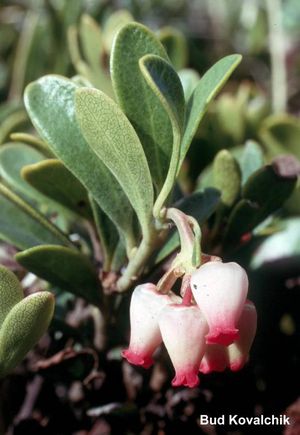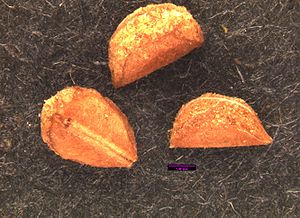Difference between revisions of "Arctostaphylos uva-ursi"
(→Description) (Tag: VisualEditor) |
|||
| (36 intermediate revisions by 6 users not shown) | |||
| Line 1: | Line 1: | ||
| − | === | + | * Scientific Name: ''Arctostaphylos'' ''uva-ursi'' |
| − | ''' | + | * Family: Ericaceae |
| + | * Common Names: red bearberry, kinnikinnik | ||
| + | * Synonyms/Misapplications: ''Arbutus'' ''uva-ursi'' | ||
| + | * Codon: ARCUVA | ||
| + | ---- | ||
| + | [[File:ARCUVA1.jpg |thumb|Photo by Bernard Kovalchik. Also featured on Main Page]] | ||
| + | === Taxonomy === | ||
| + | {{Taxobox | ||
| + | | image = | ||
| + | | image_caption =Photo by Bernard Kovalchik. Also featured on Main Page | ||
| + | | name = | ||
| + | | regnum = [[Plant]]ae | ||
| + | | subregnum = Viridiplantae | ||
| + | | phylum = Tracheophyta | ||
| + | | subphylum= Spermatophytina | ||
| + | | classis = Magnoliopsida | ||
| + | | subclassis = Asteranae | ||
| + | | ordo = Ericales | ||
| + | | familia = Ericaceae | ||
| + | | genus = ''Arctostaphylos'' Adans. | ||
| + | | species = '''''Arctostaphylos uva-ursi''''' (L.) Spreng | ||
| + | | subspecies = | ||
| + | | synonyms = *''Arctostaphylos adenotricha'' (Fernald & J.F. Macbr.) A. Löve & D. Löve & Kapoor | ||
| + | *''Uva-Ursi uva-ursi'' (L.) Britton | ||
| + | }} | ||
| + | <ref>Integrated Taxonomic Information System. Retrieved from https://www.itis.gov/servlet/SingleRpt/SingleRpt?search_topic=TSN&search_value=23530</ref> | ||
| + | ===Description=== | ||
| + | Perennial, prostrate shrub with spreading, rooting stolons, leathery evergreen leaves, urn-shaped flowers becoming red berries.<ref name=":0" /> Stems with reddish bark, sparsely hairy.<ref>Flora of North America. Retrieved from http://dev.floranorthamerica.org/Arctostaphylos_uva-ursi</ref> Leaves oblanceolate to spatulate, alternate, shiny above. Inflorescences racemous, pendant.<ref>Jepson Herbarium Online Flora. Retrieved from https://ucjeps.berkeley.edu/eflora/eflora_display.php?tid=13990</ref> Flowers 5-merous, white to pinkish; corolla fused, urn shaped; stamens 10, hairy basally, awned, dehiscent by terminal pore;<ref>Hitchcock, C. L., Cronquist, A., Giblin, D., | ||
| + | & Legler, B. et al. (2018). ''Flora of the Pacific Northwest: an | ||
| + | illustrated manual''. Seattle: University of Washington Press. p. 402.</ref> ovary superior, becoming bright red berries.<ref name=":0" /> | ||
| + | ===Bloom Period=== | ||
| + | April - June<ref name=":0">WTU | ||
| + | Herbarium, Burke Museum, & University of Washington. Retrieved from http://biology.burke.washington.edu/herbarium/imagecollection/taxon.php?Taxon=Arctostaphylos%20uva-ursi</ref> | ||
| + | ===Distribution=== | ||
| + | Alaska south to California and New Mexico, east to the Atlantic Coast; also in Eurasia.<ref name=":0" /> | ||
| + | ===Habitat=== | ||
| + | Prairies and dry meadows, dry coniferous forests, coastal bluffs.<ref name=":0" /> Medium and coarse, nitrogen poor soils.<ref>Klinka et al., 1989</ref> | ||
| + | |||
| + | ===Uses=== | ||
| + | Use by many First Nations as a smoke plant, food source, diuretic, for kidney treatment and as jewelry.<ref>Native | ||
| + | American Ethnobotany Database. Retrieved from http://naeb.brit.org/uses/search/?string=Arctostaphylos+uva-ursi</ref> | ||
| + | |||
| + | ===Propagation=== | ||
| + | |||
| + | |||
| + | [https://npn.rngr.net/npn/propagation/protocols/ericaceae-arctostaphylos-2765/?searchterm=Arctostaphylos%20uva-ursi Native Plant Network Propagation Protocol] | ||
| + | |||
| + | ===Seed=== | ||
| + | [[File:Arctostaphylis uva-ursi.jpg|300px|thumb|''Arctostaphylos uva-ursi,'' photo by Lisa Hintz]] | ||
'''Seed sample from:''' 2009 | '''Seed sample from:''' 2009 | ||
| − | '''Measurement:''' 3.9 x 2.3 x 1.8 | + | '''Average Measurement:''' 3.9 x 2.3 x 1.8 |
| − | ''' | + | '''Measurement Range:''' L: 3.75 - 4, W: 2.1 - 2.5, D: 1.5 - 2.25 |
| − | + | ====Features==== | |
| − | ''' | + | '''Shape:''' Fruits segmented with seeds like an orange. Individual seeds are orange segment shaped. |
| − | ''' | + | '''Color:''' Seeds brown. Hilum is a small brown dot on the ridge where the two flat planes of the segment come together. |
| − | + | '''Surface:''' Seed mostly smooth. Rounded surface of seed is ridged. It has a slight sheen on the flat planes. | |
| + | '''Latitudinal Cross Section:''' triangular [[File:ARUV lat.png]] | ||
| + | '''Longitudinal Cross Section:''' elliptical [[File:ARUV long.png]] | ||
{{Basics}} | {{Basics}} | ||
| + | |||
| + | ===Photo Gallery=== | ||
| + | <gallery> | ||
| + | File:ARCUVA2.jpg|Photo: Bernard Kovalchik | ||
| + | </gallery> | ||
| + | ===References=== | ||
| + | <references /> | ||
Latest revision as of 18:14, 24 June 2021
- Scientific Name: Arctostaphylos uva-ursi
- Family: Ericaceae
- Common Names: red bearberry, kinnikinnik
- Synonyms/Misapplications: Arbutus uva-ursi
- Codon: ARCUVA
Contents
Taxonomy
| Scientific classification | |
|---|---|
| Kingdom: | Plantae |
| Subkingdom: | Viridiplantae |
| Phylum: | Tracheophyta |
| Subphylum: | Spermatophytina |
| Class: | Magnoliopsida |
| Subclass: | Asteranae |
| Order: | Ericales |
| Family: | Ericaceae |
| Genus: | Arctostaphylos Adans. |
| Species: | Arctostaphylos uva-ursi (L.) Spreng |
| Synonyms | |
| |
Description
Perennial, prostrate shrub with spreading, rooting stolons, leathery evergreen leaves, urn-shaped flowers becoming red berries.[2] Stems with reddish bark, sparsely hairy.[3] Leaves oblanceolate to spatulate, alternate, shiny above. Inflorescences racemous, pendant.[4] Flowers 5-merous, white to pinkish; corolla fused, urn shaped; stamens 10, hairy basally, awned, dehiscent by terminal pore;[5] ovary superior, becoming bright red berries.[2]
Bloom Period
April - June[2]
Distribution
Alaska south to California and New Mexico, east to the Atlantic Coast; also in Eurasia.[2]
Habitat
Prairies and dry meadows, dry coniferous forests, coastal bluffs.[2] Medium and coarse, nitrogen poor soils.[6]
Uses
Use by many First Nations as a smoke plant, food source, diuretic, for kidney treatment and as jewelry.[7]
Propagation
Native Plant Network Propagation Protocol
Seed
Seed sample from: 2009
Average Measurement: 3.9 x 2.3 x 1.8
Measurement Range: L: 3.75 - 4, W: 2.1 - 2.5, D: 1.5 - 2.25
Features
Shape: Fruits segmented with seeds like an orange. Individual seeds are orange segment shaped.
Color: Seeds brown. Hilum is a small brown dot on the ridge where the two flat planes of the segment come together.
Surface: Seed mostly smooth. Rounded surface of seed is ridged. It has a slight sheen on the flat planes.
Latitudinal Cross Section: triangular ![]()
Longitudinal Cross Section: elliptical ![]()
Basic Explanations and Assumptions:
The dimensions for the seeds are length x width x depth. The location of the hilum is used as the base of the seed, and the length is measured from hilum to the opposite apex. Where a style is present, the length is measured from the hilum to the bottom of the style. Width is measured at a right angle to the length at the widest part. Depth is measured at a right angle to the intersection of height and width lines.
Measurements included are the mean average for each measurement of ten separate seeds.
All measurements in millimeters unless otherwise noted.
Photo Gallery
References
- ↑ Integrated Taxonomic Information System. Retrieved from https://www.itis.gov/servlet/SingleRpt/SingleRpt?search_topic=TSN&search_value=23530
- ↑ 2.0 2.1 2.2 2.3 2.4 WTU Herbarium, Burke Museum, & University of Washington. Retrieved from http://biology.burke.washington.edu/herbarium/imagecollection/taxon.php?Taxon=Arctostaphylos%20uva-ursi
- ↑ Flora of North America. Retrieved from http://dev.floranorthamerica.org/Arctostaphylos_uva-ursi
- ↑ Jepson Herbarium Online Flora. Retrieved from https://ucjeps.berkeley.edu/eflora/eflora_display.php?tid=13990
- ↑ Hitchcock, C. L., Cronquist, A., Giblin, D., & Legler, B. et al. (2018). Flora of the Pacific Northwest: an illustrated manual. Seattle: University of Washington Press. p. 402.
- ↑ Klinka et al., 1989
- ↑ Native American Ethnobotany Database. Retrieved from http://naeb.brit.org/uses/search/?string=Arctostaphylos+uva-ursi



